Analysis of 'Looking Out for Sarah': Disability in Children's Books
VerifiedAdded on 2022/12/28
|7
|1467
|43
Report
AI Summary
This report analyzes the children's book 'Looking Out for Sarah,' which tells the story of Sarah Gregory Smith and her guide dog Perry. The report examines the book's relevance for children aged 3-5, focusing on its portrayal of Sarah's visual impairment and how she navigates daily life with Perry. The analysis highlights the book's narrative perspective from the dog, its use of simple illustrations and language, and its emphasis on acceptance and normalcy. The report discusses how the book conveys positive messages about disability, promoting empathy and understanding in young children. It also explores how the book can be used in early childhood education to discuss special needs, friendship, and achieving goals, supported by relevant scholarly references. The report emphasizes the importance of inclusive environments and the role of literature in shaping children's perspectives on disability, referencing studies on socio-cultural attitudes and the impact of early exposure to diverse representations.
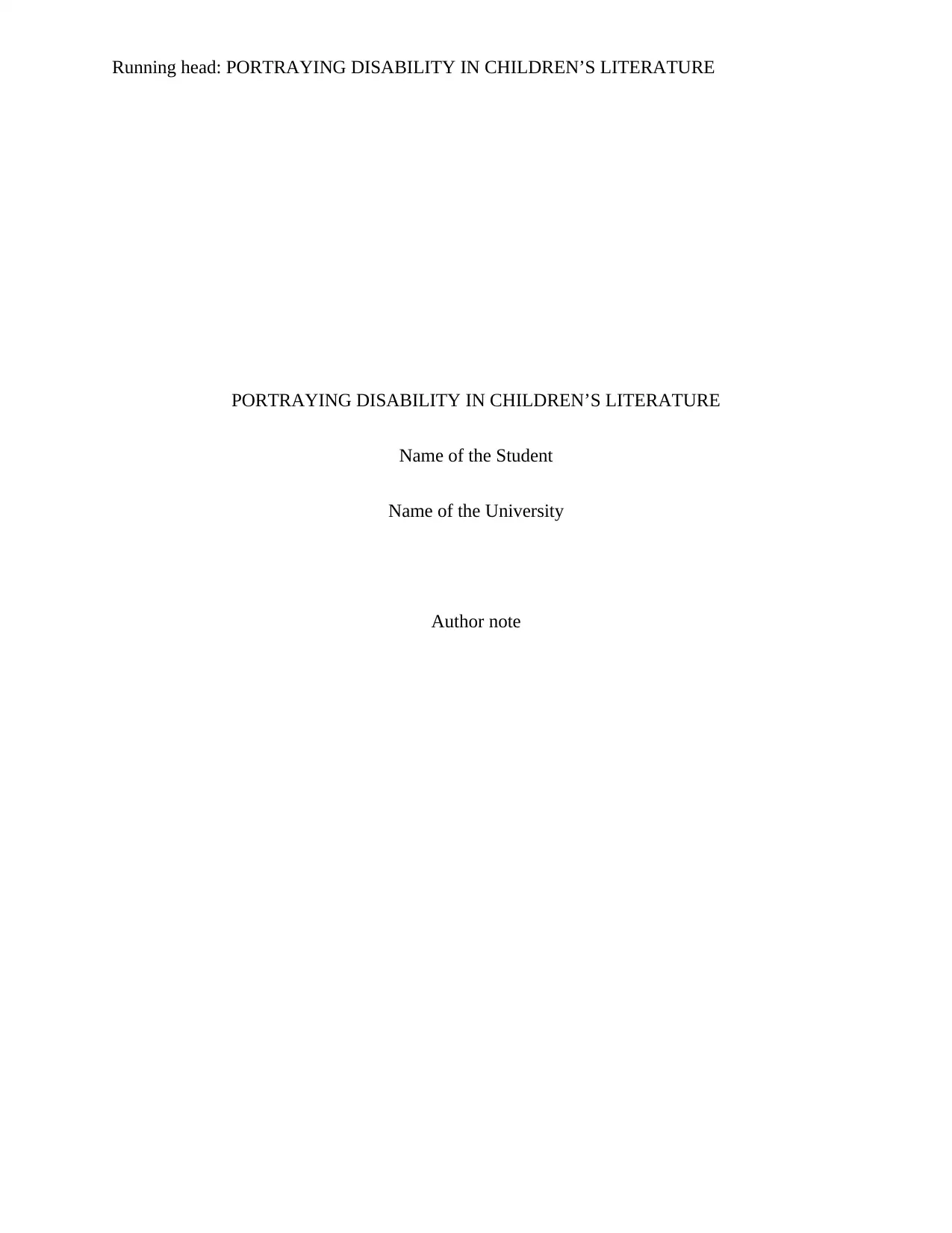
Running head: PORTRAYING DISABILITY IN CHILDREN’S LITERATURE
PORTRAYING DISABILITY IN CHILDREN’S LITERATURE
Name of the Student
Name of the University
Author note
PORTRAYING DISABILITY IN CHILDREN’S LITERATURE
Name of the Student
Name of the University
Author note
Paraphrase This Document
Need a fresh take? Get an instant paraphrase of this document with our AI Paraphraser
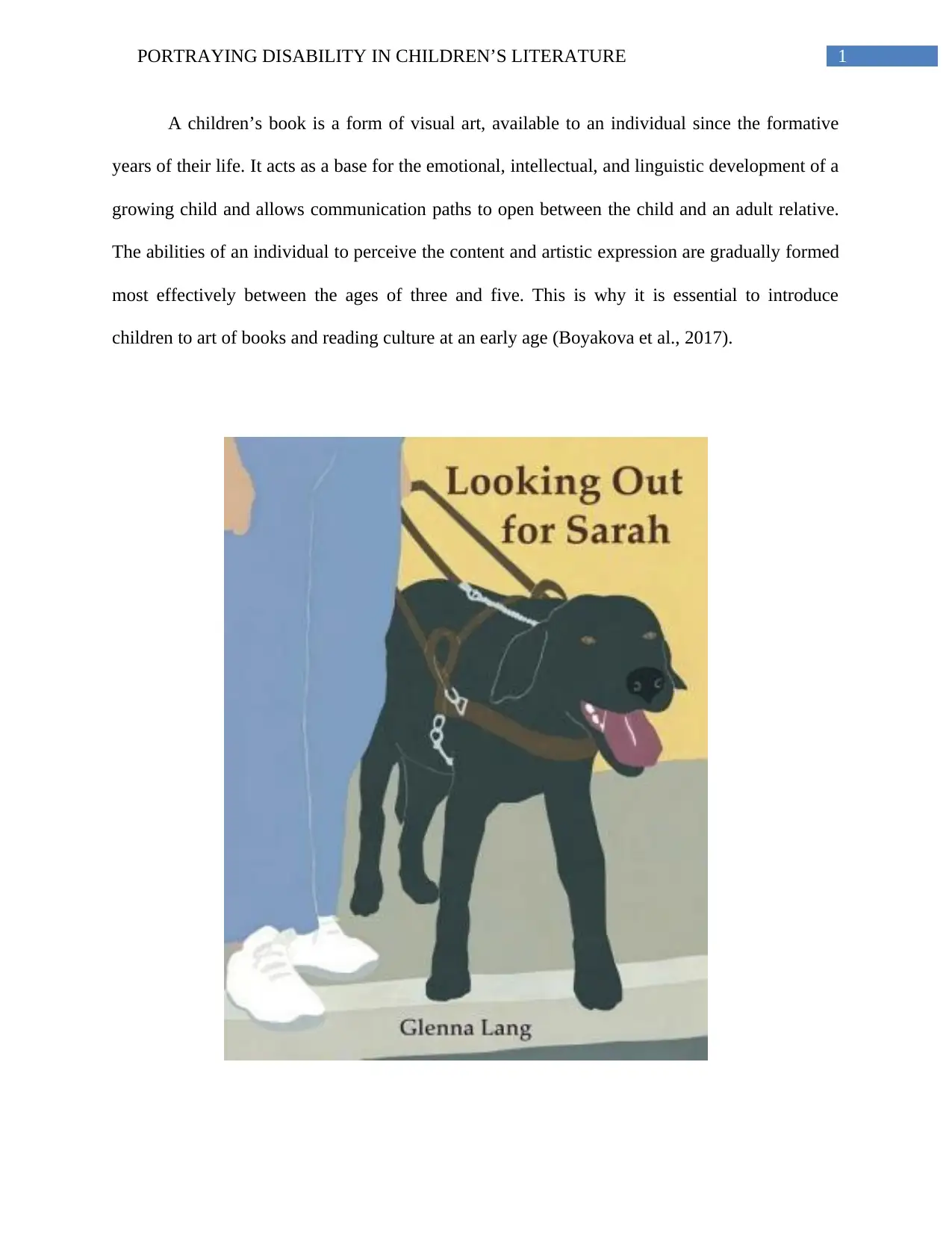
1PORTRAYING DISABILITY IN CHILDREN’S LITERATURE
A children’s book is a form of visual art, available to an individual since the formative
years of their life. It acts as a base for the emotional, intellectual, and linguistic development of a
growing child and allows communication paths to open between the child and an adult relative.
The abilities of an individual to perceive the content and artistic expression are gradually formed
most effectively between the ages of three and five. This is why it is essential to introduce
children to art of books and reading culture at an early age (Boyakova et al., 2017).
A children’s book is a form of visual art, available to an individual since the formative
years of their life. It acts as a base for the emotional, intellectual, and linguistic development of a
growing child and allows communication paths to open between the child and an adult relative.
The abilities of an individual to perceive the content and artistic expression are gradually formed
most effectively between the ages of three and five. This is why it is essential to introduce
children to art of books and reading culture at an early age (Boyakova et al., 2017).
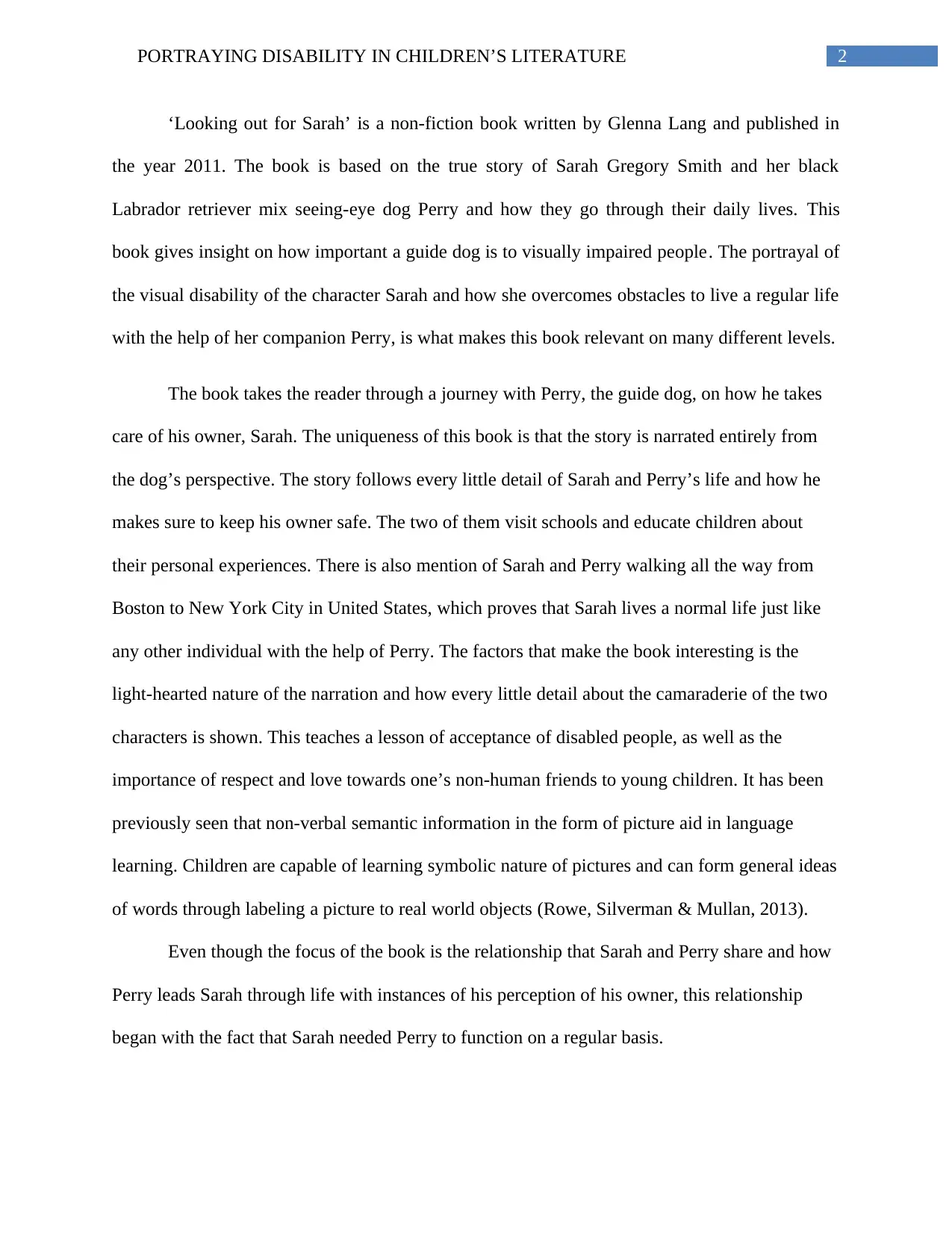
2PORTRAYING DISABILITY IN CHILDREN’S LITERATURE
‘Looking out for Sarah’ is a non-fiction book written by Glenna Lang and published in
the year 2011. The book is based on the true story of Sarah Gregory Smith and her black
Labrador retriever mix seeing-eye dog Perry and how they go through their daily lives. This
book gives insight on how important a guide dog is to visually impaired people. The portrayal of
the visual disability of the character Sarah and how she overcomes obstacles to live a regular life
with the help of her companion Perry, is what makes this book relevant on many different levels.
The book takes the reader through a journey with Perry, the guide dog, on how he takes
care of his owner, Sarah. The uniqueness of this book is that the story is narrated entirely from
the dog’s perspective. The story follows every little detail of Sarah and Perry’s life and how he
makes sure to keep his owner safe. The two of them visit schools and educate children about
their personal experiences. There is also mention of Sarah and Perry walking all the way from
Boston to New York City in United States, which proves that Sarah lives a normal life just like
any other individual with the help of Perry. The factors that make the book interesting is the
light-hearted nature of the narration and how every little detail about the camaraderie of the two
characters is shown. This teaches a lesson of acceptance of disabled people, as well as the
importance of respect and love towards one’s non-human friends to young children. It has been
previously seen that non-verbal semantic information in the form of picture aid in language
learning. Children are capable of learning symbolic nature of pictures and can form general ideas
of words through labeling a picture to real world objects (Rowe, Silverman & Mullan, 2013).
Even though the focus of the book is the relationship that Sarah and Perry share and how
Perry leads Sarah through life with instances of his perception of his owner, this relationship
began with the fact that Sarah needed Perry to function on a regular basis.
‘Looking out for Sarah’ is a non-fiction book written by Glenna Lang and published in
the year 2011. The book is based on the true story of Sarah Gregory Smith and her black
Labrador retriever mix seeing-eye dog Perry and how they go through their daily lives. This
book gives insight on how important a guide dog is to visually impaired people. The portrayal of
the visual disability of the character Sarah and how she overcomes obstacles to live a regular life
with the help of her companion Perry, is what makes this book relevant on many different levels.
The book takes the reader through a journey with Perry, the guide dog, on how he takes
care of his owner, Sarah. The uniqueness of this book is that the story is narrated entirely from
the dog’s perspective. The story follows every little detail of Sarah and Perry’s life and how he
makes sure to keep his owner safe. The two of them visit schools and educate children about
their personal experiences. There is also mention of Sarah and Perry walking all the way from
Boston to New York City in United States, which proves that Sarah lives a normal life just like
any other individual with the help of Perry. The factors that make the book interesting is the
light-hearted nature of the narration and how every little detail about the camaraderie of the two
characters is shown. This teaches a lesson of acceptance of disabled people, as well as the
importance of respect and love towards one’s non-human friends to young children. It has been
previously seen that non-verbal semantic information in the form of picture aid in language
learning. Children are capable of learning symbolic nature of pictures and can form general ideas
of words through labeling a picture to real world objects (Rowe, Silverman & Mullan, 2013).
Even though the focus of the book is the relationship that Sarah and Perry share and how
Perry leads Sarah through life with instances of his perception of his owner, this relationship
began with the fact that Sarah needed Perry to function on a regular basis.
⊘ This is a preview!⊘
Do you want full access?
Subscribe today to unlock all pages.

Trusted by 1+ million students worldwide
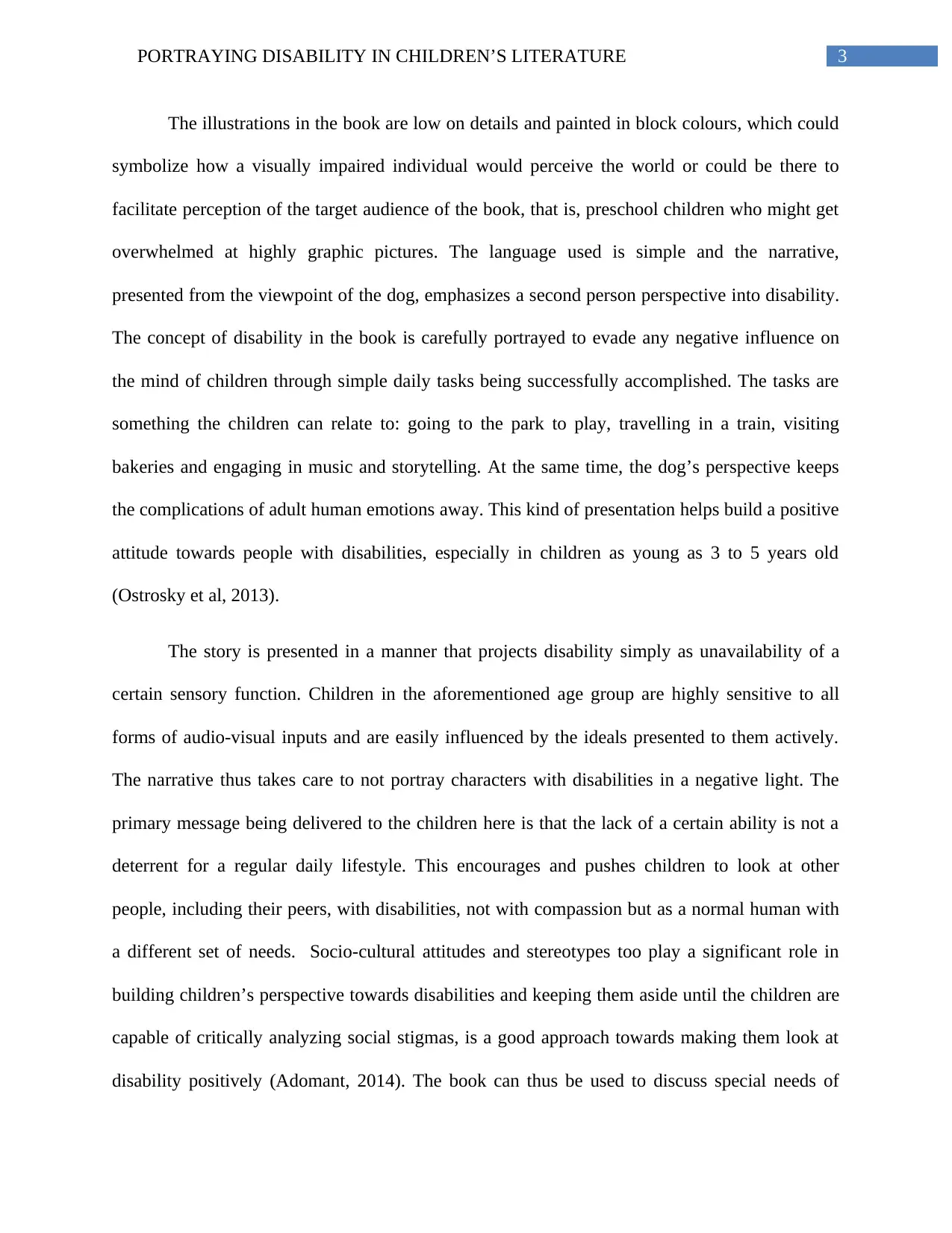
3PORTRAYING DISABILITY IN CHILDREN’S LITERATURE
The illustrations in the book are low on details and painted in block colours, which could
symbolize how a visually impaired individual would perceive the world or could be there to
facilitate perception of the target audience of the book, that is, preschool children who might get
overwhelmed at highly graphic pictures. The language used is simple and the narrative,
presented from the viewpoint of the dog, emphasizes a second person perspective into disability.
The concept of disability in the book is carefully portrayed to evade any negative influence on
the mind of children through simple daily tasks being successfully accomplished. The tasks are
something the children can relate to: going to the park to play, travelling in a train, visiting
bakeries and engaging in music and storytelling. At the same time, the dog’s perspective keeps
the complications of adult human emotions away. This kind of presentation helps build a positive
attitude towards people with disabilities, especially in children as young as 3 to 5 years old
(Ostrosky et al, 2013).
The story is presented in a manner that projects disability simply as unavailability of a
certain sensory function. Children in the aforementioned age group are highly sensitive to all
forms of audio-visual inputs and are easily influenced by the ideals presented to them actively.
The narrative thus takes care to not portray characters with disabilities in a negative light. The
primary message being delivered to the children here is that the lack of a certain ability is not a
deterrent for a regular daily lifestyle. This encourages and pushes children to look at other
people, including their peers, with disabilities, not with compassion but as a normal human with
a different set of needs. Socio-cultural attitudes and stereotypes too play a significant role in
building children’s perspective towards disabilities and keeping them aside until the children are
capable of critically analyzing social stigmas, is a good approach towards making them look at
disability positively (Adomant, 2014). The book can thus be used to discuss special needs of
The illustrations in the book are low on details and painted in block colours, which could
symbolize how a visually impaired individual would perceive the world or could be there to
facilitate perception of the target audience of the book, that is, preschool children who might get
overwhelmed at highly graphic pictures. The language used is simple and the narrative,
presented from the viewpoint of the dog, emphasizes a second person perspective into disability.
The concept of disability in the book is carefully portrayed to evade any negative influence on
the mind of children through simple daily tasks being successfully accomplished. The tasks are
something the children can relate to: going to the park to play, travelling in a train, visiting
bakeries and engaging in music and storytelling. At the same time, the dog’s perspective keeps
the complications of adult human emotions away. This kind of presentation helps build a positive
attitude towards people with disabilities, especially in children as young as 3 to 5 years old
(Ostrosky et al, 2013).
The story is presented in a manner that projects disability simply as unavailability of a
certain sensory function. Children in the aforementioned age group are highly sensitive to all
forms of audio-visual inputs and are easily influenced by the ideals presented to them actively.
The narrative thus takes care to not portray characters with disabilities in a negative light. The
primary message being delivered to the children here is that the lack of a certain ability is not a
deterrent for a regular daily lifestyle. This encourages and pushes children to look at other
people, including their peers, with disabilities, not with compassion but as a normal human with
a different set of needs. Socio-cultural attitudes and stereotypes too play a significant role in
building children’s perspective towards disabilities and keeping them aside until the children are
capable of critically analyzing social stigmas, is a good approach towards making them look at
disability positively (Adomant, 2014). The book can thus be used to discuss special needs of
Paraphrase This Document
Need a fresh take? Get an instant paraphrase of this document with our AI Paraphraser
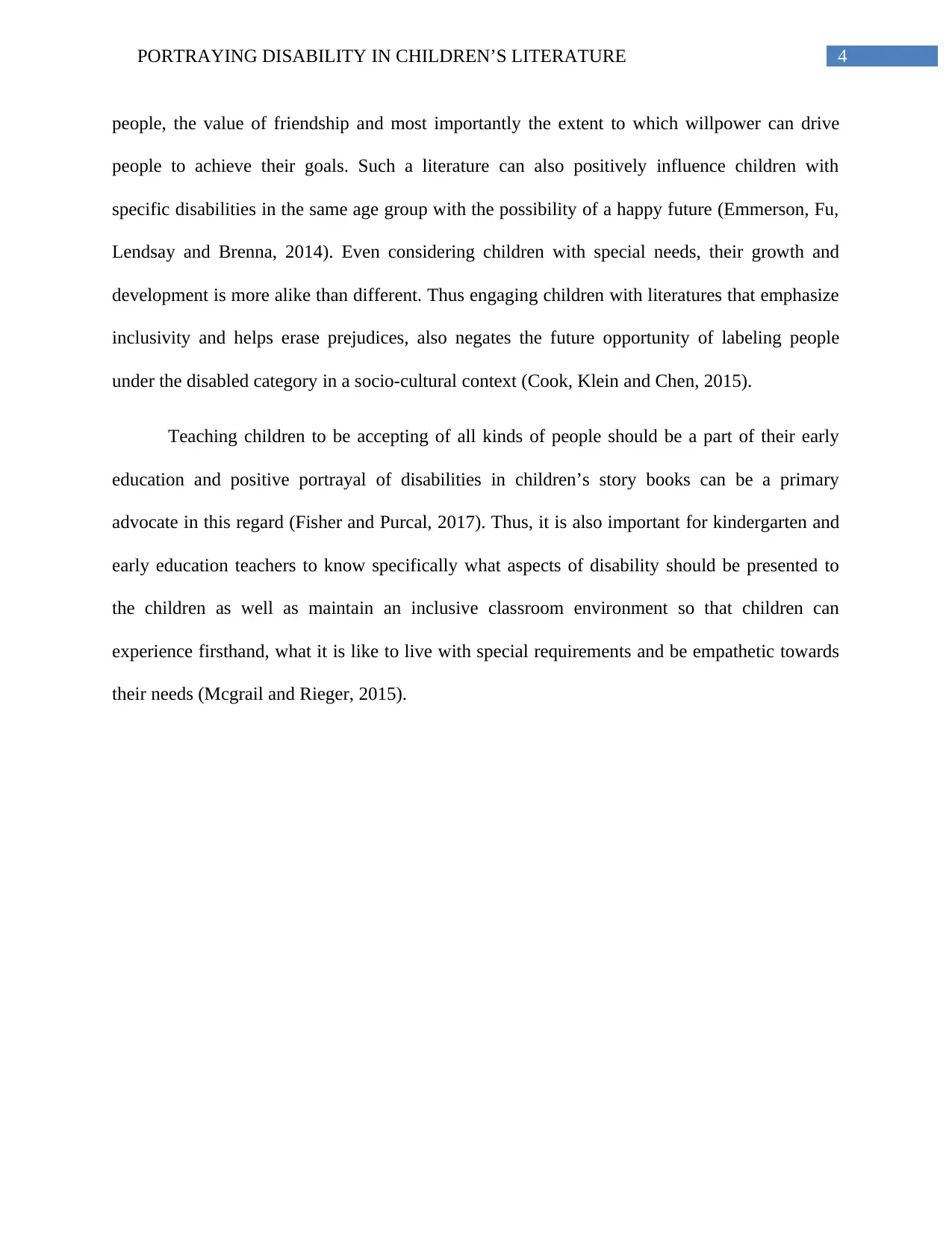
4PORTRAYING DISABILITY IN CHILDREN’S LITERATURE
people, the value of friendship and most importantly the extent to which willpower can drive
people to achieve their goals. Such a literature can also positively influence children with
specific disabilities in the same age group with the possibility of a happy future (Emmerson, Fu,
Lendsay and Brenna, 2014). Even considering children with special needs, their growth and
development is more alike than different. Thus engaging children with literatures that emphasize
inclusivity and helps erase prejudices, also negates the future opportunity of labeling people
under the disabled category in a socio-cultural context (Cook, Klein and Chen, 2015).
Teaching children to be accepting of all kinds of people should be a part of their early
education and positive portrayal of disabilities in children’s story books can be a primary
advocate in this regard (Fisher and Purcal, 2017). Thus, it is also important for kindergarten and
early education teachers to know specifically what aspects of disability should be presented to
the children as well as maintain an inclusive classroom environment so that children can
experience firsthand, what it is like to live with special requirements and be empathetic towards
their needs (Mcgrail and Rieger, 2015).
people, the value of friendship and most importantly the extent to which willpower can drive
people to achieve their goals. Such a literature can also positively influence children with
specific disabilities in the same age group with the possibility of a happy future (Emmerson, Fu,
Lendsay and Brenna, 2014). Even considering children with special needs, their growth and
development is more alike than different. Thus engaging children with literatures that emphasize
inclusivity and helps erase prejudices, also negates the future opportunity of labeling people
under the disabled category in a socio-cultural context (Cook, Klein and Chen, 2015).
Teaching children to be accepting of all kinds of people should be a part of their early
education and positive portrayal of disabilities in children’s story books can be a primary
advocate in this regard (Fisher and Purcal, 2017). Thus, it is also important for kindergarten and
early education teachers to know specifically what aspects of disability should be presented to
the children as well as maintain an inclusive classroom environment so that children can
experience firsthand, what it is like to live with special requirements and be empathetic towards
their needs (Mcgrail and Rieger, 2015).
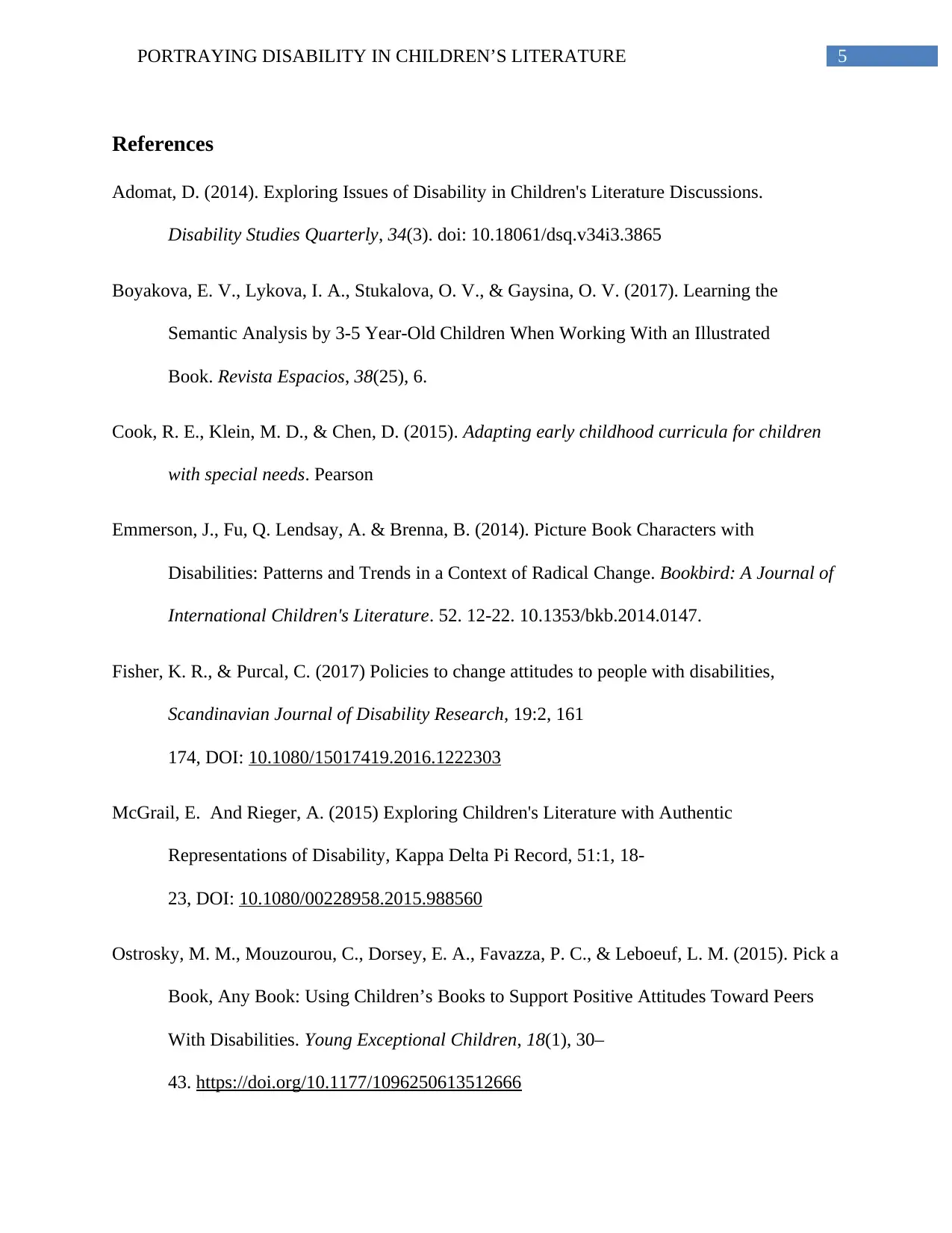
5PORTRAYING DISABILITY IN CHILDREN’S LITERATURE
References
Adomat, D. (2014). Exploring Issues of Disability in Children's Literature Discussions.
Disability Studies Quarterly, 34(3). doi: 10.18061/dsq.v34i3.3865
Boyakova, E. V., Lykova, I. A., Stukalova, O. V., & Gaysina, O. V. (2017). Learning the
Semantic Analysis by 3-5 Year-Old Children When Working With an Illustrated
Book. Revista Espacios, 38(25), 6.
Cook, R. E., Klein, M. D., & Chen, D. (2015). Adapting early childhood curricula for children
with special needs. Pearson
Emmerson, J., Fu, Q. Lendsay, A. & Brenna, B. (2014). Picture Book Characters with
Disabilities: Patterns and Trends in a Context of Radical Change. Bookbird: A Journal of
International Children's Literature. 52. 12-22. 10.1353/bkb.2014.0147.
Fisher, K. R., & Purcal, C. (2017) Policies to change attitudes to people with disabilities,
Scandinavian Journal of Disability Research, 19:2, 161
174, DOI: 10.1080/15017419.2016.1222303
McGrail, E. And Rieger, A. (2015) Exploring Children's Literature with Authentic
Representations of Disability, Kappa Delta Pi Record, 51:1, 18-
23, DOI: 10.1080/00228958.2015.988560
Ostrosky, M. M., Mouzourou, C., Dorsey, E. A., Favazza, P. C., & Leboeuf, L. M. (2015). Pick a
Book, Any Book: Using Children’s Books to Support Positive Attitudes Toward Peers
With Disabilities. Young Exceptional Children, 18(1), 30–
43. https://doi.org/10.1177/1096250613512666
References
Adomat, D. (2014). Exploring Issues of Disability in Children's Literature Discussions.
Disability Studies Quarterly, 34(3). doi: 10.18061/dsq.v34i3.3865
Boyakova, E. V., Lykova, I. A., Stukalova, O. V., & Gaysina, O. V. (2017). Learning the
Semantic Analysis by 3-5 Year-Old Children When Working With an Illustrated
Book. Revista Espacios, 38(25), 6.
Cook, R. E., Klein, M. D., & Chen, D. (2015). Adapting early childhood curricula for children
with special needs. Pearson
Emmerson, J., Fu, Q. Lendsay, A. & Brenna, B. (2014). Picture Book Characters with
Disabilities: Patterns and Trends in a Context of Radical Change. Bookbird: A Journal of
International Children's Literature. 52. 12-22. 10.1353/bkb.2014.0147.
Fisher, K. R., & Purcal, C. (2017) Policies to change attitudes to people with disabilities,
Scandinavian Journal of Disability Research, 19:2, 161
174, DOI: 10.1080/15017419.2016.1222303
McGrail, E. And Rieger, A. (2015) Exploring Children's Literature with Authentic
Representations of Disability, Kappa Delta Pi Record, 51:1, 18-
23, DOI: 10.1080/00228958.2015.988560
Ostrosky, M. M., Mouzourou, C., Dorsey, E. A., Favazza, P. C., & Leboeuf, L. M. (2015). Pick a
Book, Any Book: Using Children’s Books to Support Positive Attitudes Toward Peers
With Disabilities. Young Exceptional Children, 18(1), 30–
43. https://doi.org/10.1177/1096250613512666
⊘ This is a preview!⊘
Do you want full access?
Subscribe today to unlock all pages.

Trusted by 1+ million students worldwide
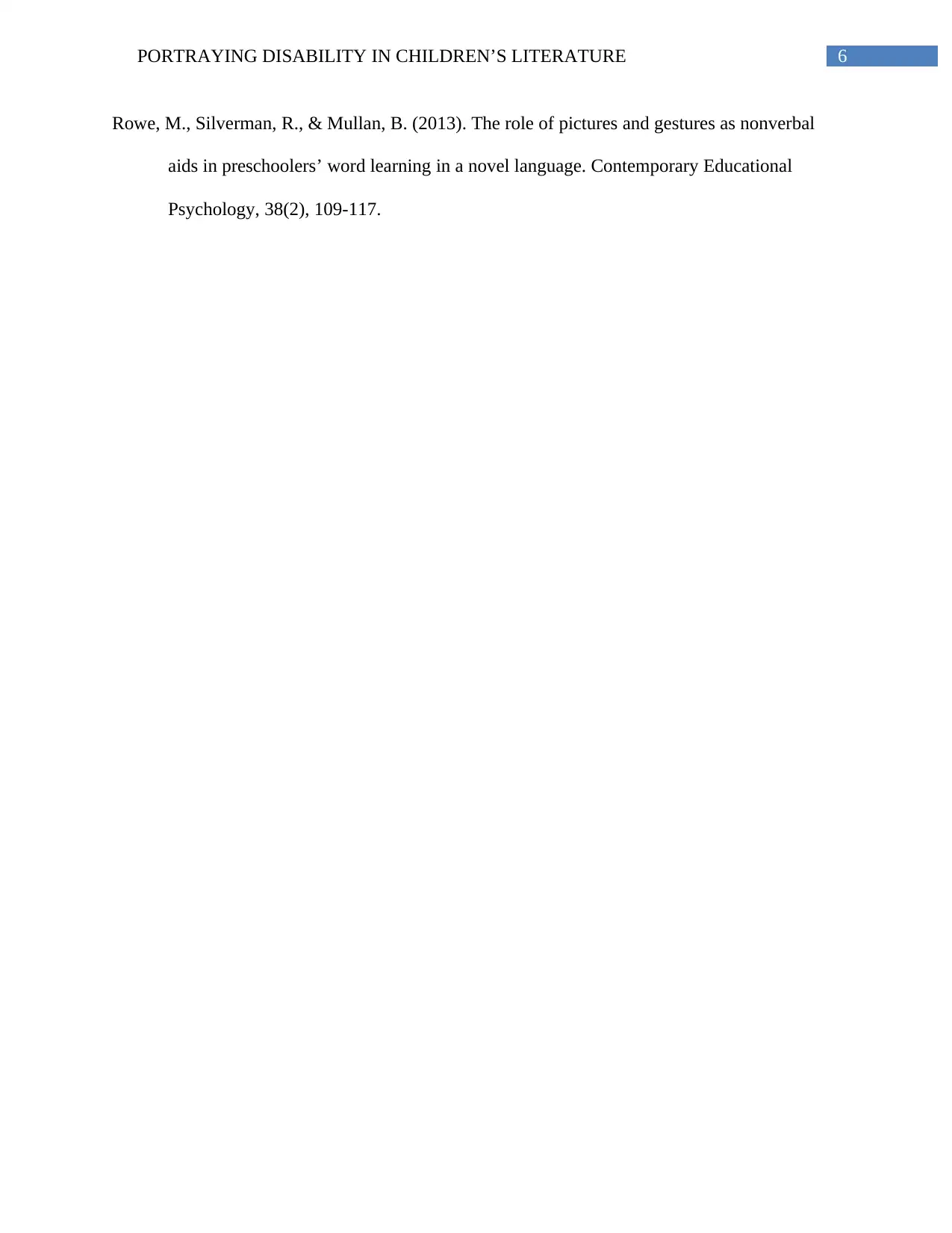
6PORTRAYING DISABILITY IN CHILDREN’S LITERATURE
Rowe, M., Silverman, R., & Mullan, B. (2013). The role of pictures and gestures as nonverbal
aids in preschoolers’ word learning in a novel language. Contemporary Educational
Psychology, 38(2), 109-117.
Rowe, M., Silverman, R., & Mullan, B. (2013). The role of pictures and gestures as nonverbal
aids in preschoolers’ word learning in a novel language. Contemporary Educational
Psychology, 38(2), 109-117.
1 out of 7
Related Documents
Your All-in-One AI-Powered Toolkit for Academic Success.
+13062052269
info@desklib.com
Available 24*7 on WhatsApp / Email
![[object Object]](/_next/static/media/star-bottom.7253800d.svg)
Unlock your academic potential
Copyright © 2020–2025 A2Z Services. All Rights Reserved. Developed and managed by ZUCOL.





